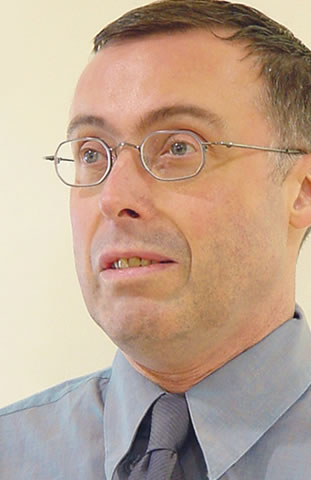EXE 2016
2nd International Workshop on Executable Modeling
October 3, 2016, Saint-Malo, France
co-located with MODELS 2016
About | Program | Proceedings | Call | Important Dates | Committees

About the Workshop
Executable models have the potential of bringing major benefits to the development of complex systems, as they provide abstractions of complex system behaviors and allow for the performance of early analyses of that behavior. Despite the potential benefits of executable models, there are still many challenges to solve, such as the lack of maturity in the definition of and tooling for executable modeling languages, and the limited experience with executable modeling in much of the software development industry. The objective of the Second International Workshop on Executable Modeling (EXE 2016) is to draw attention to the potentials and challenges of executable modeling and advance the state-of-the-art in executable modeling. We aim at bringing together researchers working towards overcoming challenges in executable modeling, as well as practitioners from different application domains and application contexts of executable modeling. The workshop intends to provide a forum for exchanging recent results, ideas, opinions, requirements, and experiences in executable modeling.
Program
The workshop will take place at the room Lamennais 1.
Detailed Schedule
9:00 – 10:30 Session 1: Opening and Keynote
10:30 – 11:00 Coffee Break
11:00 – 12:30 Session 2: Paper Presentations
| 11:00 – 11:30 | Defining Semantic Variations of Diagrammatic Languages Using Behavioral Programming and Queries (Research Paper) Michael Bar-Sinai, Gera Weiss and Assaf Marron Paper | Slides |
| 11:30 – 12:00 | Concurrency-aware Executable Domain-Specific Modeling Languages as Models of Concurrency (Research Paper) Florent Latombe, Xavier Crégut and Marc Pantel Paper | Slides |
| 12:00 – 12:30 | Interactive Debugging for Extensible Languages in Multi-Stage Transformation Environments (Research Paper) Domenik Pavletic and Kim Haßlbauer Paper | Slides |
12:30 – 14:00 Lunch Break
14:00 – 15:30 Session 3: Paper Presentations
| 14:00 – 14:20 | xtUML: Current and Next State of a Modeling Dialect (Experience Report and Historical View) Cortland Starrett Paper | Slides |
| 14:20 – 14:50 | Local Optimizations in Eclipse QVTc and QVTr using the Micro-Mapping Model of Computation (Research Paper) Edward D. Willink Paper | Slides |
| 14:50 – 15:10 | SimQRi – A Query-oriented Tool for the Efficient Simulation and Analysis of Process Models (Tool Demonstration) Christophe Ponsard, Quentin Boucher and Gustavo Ospina Paper | Supplement | Slides |
| 15:10 – 15:30 | Invited Talk Resource Analysis and Automated Verification for the Thirty Meter Telescope using Executable SysML Models Nerijus Jankevicius Paper | Slides |
15:30 – 16:00 Coffee Break
| 16:00 – 16:15 | On Leveraging Executable Language Engineering for Domain-Specific Transformation Languages (Position Paper) Erwan Bousse, Manuel Wimmer, Wieland Schwinger and Elisabeth Kapsammer Paper | Slides |
| 16:15 – 16:30 | On the Executable Nature of Models (Position Paper) Eric Cariou, Olivier Le Goaer and Franck Barbie Paper | Slides |
| 16:30 – 17:20 | Plenary Discussion Results |
| 17:20 – 17:30 | Workshop Closing Slides |
Keynote “Executable Modeling: Retrospective and Prospective” by Stephen Mellor

Abstract
In the mid-Eighties, there were thirty object-oriented notations and thirty object-oriented methods. These fell into three main groups: sketches of software structure, depictions of software (usually with gaps to fill in the code) and what we now call executable models. By the late-Nineties, there was one notation and zero methods. Executable models were hard to find. The method wars were over. We (all) lost. Worse, models as graphical descriptions of code are “just documentation”, overhead that gets in the way of the real thing: code. The Agile Manifesto of 2001 elevates “working software” over models. But “software” can also mean executable models.
The difference between a programming language and an action language is, as always, the level of abstraction. Programming languages are ‘aware’ of data structures and threads of control. Action languages can abstract these away. Over more than a decade an action language has been added to UML and open-source implementations made available. Defined semantics are now on the horizon for state models. Perhaps UML can be made executable after all.
That will help, but it’s not enough. We need our executable models to be composable so that when two components have been tested and the manner of their interactions tested too, we can have confidence that the combined component works. We need this now we are connecting industrial control systems to the Internet. Composable execution units are needed to bring executable modeling to growing industrial applications.
Biography
Stephen Mellor is the Chief Technical Officer for the Industrial Internet Consortium, where he directs the standards requirements and technology and security priorities for the Industrial Internet. In that role, he coordinates the activities of the several engineering, architecture, security and testbed working groups and teams.
He is a well-known technology consultant on methods for the construction of real-time and embedded systems, a signatory to the Agile Manifesto, and adjunct professor at the Australian National University in Canberra, ACT, Australia. Stephen is the author of Structured Development for Real-Time Systems, Object Lifecycles, Executable UML, and MDA Distilled.
Proceedings
The proceedings of the workshop are published in the CEUR workshop proceedings volume 1760.
Call for Papers
Context
The complexity of modern software systems, time-to-market pressures, and the need for high quality software are current challenges faced by the software industry. To address these challenges, model-driven engineering (MDE) advocates the elevation of models into the center of the development process. Models provide abstractions over the system to be developed, while also providing enough detail to automate the development of implementation artifacts and perform early software analysis. In this context, executable models become more and more important. Executable models provide abstractions of a system’s behavior and constitute the basis for performing early analyses of that behavior. The ability to analyze a system’s behavior early in its development has the potential to turn executable models into important assets of a model-driven software development process.
Scope and Topics
Despite the potential benefits of executable models, there are still many challenges to solve, such as the lack of maturity in the definition of and tooling for executable modeling languages, and the limited experience with executable modeling in much of the software development industry. EXE 2016 will provide a forum for researchers and practitioners to discuss these challenges and propose potential solutions, as well as to assess and advance the state-of-the-art in this area.
Topics of interest for the workshop include but are not limited to the following:
- Methodologies, languages, techniques, and methods for designing and implementing executable modeling languages
- Model execution tools for the validation, verification, and testing of systems (e.g., model animation, debugging, simulation, trace exploration, model checking, symbolic execution)
- Case studies and experience reports on the successful or failed adoption of executable modeling in different application domains and application contexts
- Empirical investigations and evaluations of model execution tools
- Executable modeling in education
- Automation techniques for the development of model execution tools
- Evolution in the context of executable modeling (e.g., evolution of executable modeling languages, execution semantics, executable models, model execution tools)
- Verification of semantic conformance (e.g., among executable modeling languages, executable models, model execution tools)
- Customization of executable modeling languages and model execution tools (e.g., semantic variation points, profiles)
- Composition, extension, and reuse of executable modeling languages and model execution tools
- Integration of executable modeling languages and programming languages
- Semantics-aware model transformations and code generation
- Scalability of model execution and execution-based model analysis
- Execution of partial and underspecified models
- Model execution in the presence of non-determinism and concurrency
- Surveys and benchmarks of different approaches for the development of executable modeling languages, model execution, and execution-based model analysis
Submissions
We will accept the following types of submissions (please indicate the type of your submission as a footnote to the title of your paper):
- Research papers (up to 7 pages) presenting novel and innovative approaches in one of the topics of the workshop. We also strongly encourage the submission of comparative studies and benchmarks of existing approaches in one of the topics.
- Experience reports (up to 7 pages) presenting experiences and lessons learned in one of the topics of the workshop. Experience reports should discuss knowledge gained from an executable modeling project experience and identify key challenges encountered.
- Position papers (up to 3 pages) presenting new ideas or early research results in one of the topics of the workshop.
- Tool demonstration papers (up to 3 pages) presenting novel tools or novel features of state-of-the-art tools related to executable modeling. Submissions of tool demonstration papers should consist of two parts. The first part (up to 3 pages) will be included in the proceedings and should describe the tool presented (please include the URL of the tool if available). The second part (up to 2 pages) should explain how the tool demonstration will be carried out at the workshop, including examples and screenshots.
All submissions should follow the IEEE formatting instructions. Please submit your paper electronically as PDF via EasyChair at https://easychair.org/conferences/?conf=exe2016.
All submissions will be evaluated by at least three members of the program committee. Research papers, experience reports, and tool demonstration papers will be evaluated concerning novelty, correctness, significance, readability, and alignment with the workshop call. Position papers will be evaluated primarily concerning validity and ability to generate discussion (even controversy), as well as alignment with the workshop call. Furthermore, all submissions must be original work and must not have been previously published or being under review elsewhere.
For each accepted paper, at least one of the authors must register for the workshop, participate fully in the workshop, and present the paper at the workshop. A pre-workshop version of the accepted papers will be available on the workshop website and a post-workshop version will be published as part of the workshop’s post-proceedings at CEUR workshop proceedings.
Important Dates
- Submission deadline: July 17, 2016
- Author notification: August 14, 2016
- Workshop: October 3, 2016
Workshop Format
EXE 2016 is a full-day workshop held as part of MODELS 2016. We plan to have one keynote talk in the morning, followed by two sessions of presentations of the accepted papers. The last session of the day will be a discussion session, where challenges, questions, experiences, opinions, and requirements related to executable modeling will be discussed.
Committees
Organizers
- Tanja Mayerhofer, TU Wien, Austria
- Philip Langer, EclipseSource, Austria
- Ed Seidewitz, independent, USA
- Jeff Gray, University of Alabama, USA
Program Committee
- Colin Atkinson, University of Mannheim, Germany
- Francis Bordeleau, Ericsson, Canada
- Jordi Cabot, ICREA – UOC, Spain
- Tony Clark, Sheffield Hallam University, United Kingdom
- Peter Clarke, Florida International University, United States
- Benoit Combemale, IRISA and University of Rennes, France
- Julien Deantoni, University Nice Sophia Antipolis, CNRS, I3S, Inria, France
- Juergen Dingel, Queen’s University, Canada
- Martin Gogolla, University of Bremen, Germany
- Timothy Lethbridge, University of Ottawa, Canada
- Nicholas Matragkas, University of Hull, United Kingdom
- Marjan Mernik, University of Maribor, Slovenia
- Zoltan Micskei, Budapest University of Technology and Economics, Hungary
- Richard Paige, University of York, United Kingdom
- Alessandro Romero, Brazilian National Institute for Space Research, Brazil
- Bernhard Rumpe, RWTH Aachen University, Germany
- Jesús Sánchez Cuadrado, Universidad Autónoma de Madrid, Spain
- Markus Scheidgen, Humboldt University Berlin, Germany
- Bran Selic, Malina Software Corporation, Canada
- Cortland Starrett, One Fact Inc, United States
- Eugene Syriani, University of Montreal, Canada
- Jérémie Tatibouët, CEA, France
- Massimo Tisi, Ecole des Mines de Nantes, France
- Mark van den Brand, Eindhoven University of Technology, The Netherlands
- Hans Vangheluwe, University of Antwerp, Belgium and McGill University, Canada
Previous Editions
- EXE 2015, September 27th, 2015, Ottawa, Canada
Contact
If you have further questions about EXE 2016, do not hesitate and contact us via an email to:
exe2016 [at] modelexecution.org

